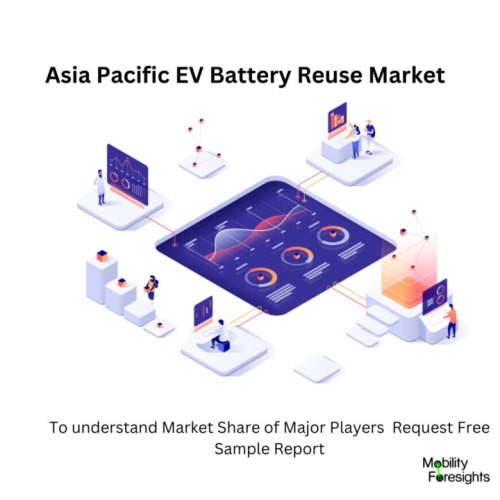
- Get in Touch with Us

Last Updated: Apr 25, 2025 | Study Period: 2024-2030
Electric vehicles (EVs) have emerged as a promising solution to address environmental concerns and reduce greenhouse gas emissions in the transportation sector. As the adoption of EVs continues to grow, one pressing issue arises: the management of used electric vehicle batteries. These batteries, while no longer suitable for the demanding requirements of automotive use, often retain a significant amount of their capacity and potential for other applications. This has led to the concept of EV battery reuse, a sustainable approach that maximizes the value of these batteries beyond their initial purpose.
EV battery reuse involves repurposing used electric vehicle batteries for secondary applications instead of recycling them outright. Recycling is an essential aspect of managing end-of-life EV batteries, but reuse offers additional benefits, making it an attractive proposition for various stakeholders.One of the primary benefits of EV battery reuse is its contribution to reducing environmental impact. By extending the lifespan of these batteries, we can maximize the energy and resources invested in their initial production. The manufacturing of EV batteries involves significant resource consumption and emissions. By reusing these batteries, we can lower the demand for new battery production, which, in turn, decreases the associated environmental footprint.
Moreover, the reuse of EV batteries can help in smoothing the integration of renewable energy sources into the power grid. As renewable energy generation, such as solar and wind, is intermittent, it is essential to store excess energy for later use. Used EV batteries with slightly reduced capacity can serve this purpose effectively. They can be integrated into energy storage systems to store surplus renewable energy during periods of high generation and release it during peak demand or when renewable energy sources are not producing electricity. This enhances the overall efficiency and reliability of renewable energy systems, making them more viable alternatives to fossil fuel-based power generation.
In conclusion, EV battery reuse presents a sustainable and economically viable solution to manage end-of-life electric vehicle batteries. By repurposing these batteries for secondary applications, we can reduce their environmental impact, enhance the integration of renewable energy sources, and contribute to the development of a circular economy. To fully realize the potential of EV battery reuse, collaboration between stakeholders, standardization, and supportive policies are essential. As the world continues to transition towards a cleaner and greener future, EV battery reuse stands as a testament to innovative thinking and responsible resource management.

The Asia Pacific EV Battery Reuse Market accounted for $XX Billion in 2023 and is anticipated to reach $XX Billion by 2030, registering a CAGR of XX% from 2024 to 2030.
| Sl no | Topic |
| 1 | Market Segmentation |
| 2 | Scope of the report |
| 3 | Abbreviations |
| 4 | Research Methodology |
| 5 | Executive Summary |
| 6 | Introduction |
| 7 | Insights from Industry stakeholders |
| 8 | Cost breakdown of Product by sub-components and average profit margin |
| 9 | Disruptive innovation in the Industry |
| 10 | Technology trends in the Industry |
| 11 | Consumer trends in the industry |
| 12 | Recent Production Milestones |
| 13 | Component Manufacturing in US, EU and China |
| 14 | COVID-19 impact on overall market |
| 15 | COVID-19 impact on Production of components |
| 16 | COVID-19 impact on Point of sale |
| 17 | Market Segmentation, Dynamics and Forecast by Geography, 2024-2030 |
| 18 | Market Segmentation, Dynamics and Forecast by Product Type, 2024-2030 |
| 19 | Market Segmentation, Dynamics and Forecast by Application, 2024-2030 |
| 20 | Market Segmentation, Dynamics and Forecast by End use, 2024-2030 |
| 21 | Product installation rate by OEM, 2023 |
| 22 | Incline/Decline in Average B-2-B selling price in past 5 years |
| 23 | Competition from substitute products |
| 24 | Gross margin and average profitability of suppliers |
| 25 | New product development in past 12 months |
| 26 | M&A in past 12 months |
| 27 | Growth strategy of leading players |
| 28 | Market share of vendors, 2023 |
| 29 | Company Profiles |
| 30 | Unmet needs and opportunity for new suppliers |
| 31 | Conclusion |
| 32 | Appendix |